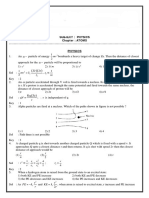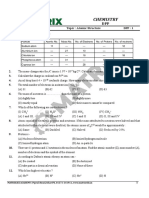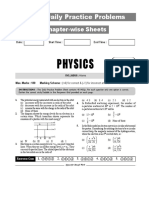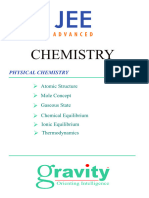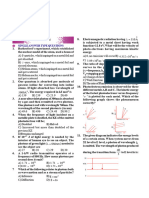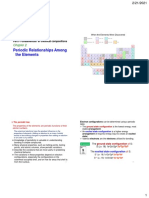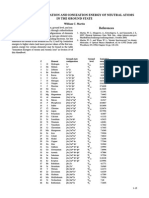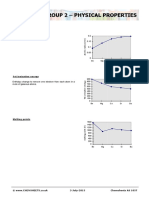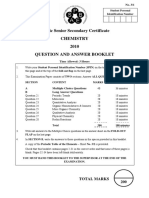ASSIGNMENT#2 BOHR’S MODEL ATOMIC STRUCTURE
Section (A) : Calculation related to nucleus
A-1. The element having no neutron in the nucleus of its atom is
(A) Hydrogen (B) Nitrogen (C) Helium (D) Boron
A-2. The ratio of the "e/m" (specific charge) values of a electron and an -particle is -
(A) 2 : 1 (B) 1 : 1 (C) 1 : 2 (D) None of these
A-3. The fraction of volume occupied by the nucleus with respect to the total volume of an atom is
(A) 10–15 (B) 10–5 (C) 10–30 (D) 10–10
A-4.* Which of the following is iso-electronic with neon?
(A) O2– (B) F– (C) Mg (D) Na
64
A-5. The approximate size of the nucleus of 28 Ni is :
(A) 3 fm (B) 4 fm (C) 5 fm (D) 2 fm
Section (B) : Quantum theory of light & Photoelectric EfFect
B-1. The value of Planck’s constant is 6.63 × 10–34 Js. The velocity of light is 3 × 108 m/sec. Which value is closest
to the wavelength of a quantum of light with frequency of 8 × 1015 sec–1 ?
(A) 5 × 10–18 m (B) 4 × 10–8 m (C) 3 × 107 m (D) 2 × 10–25 m
B-2. The MRI (magentic resonance imaging) body scanners used in hospitals operate with 400 MHz radio frequency.
The wavelength corresponding to this radio frequency is
(A) 0.75 m (B) 0.75 cm (C) 1.5 m (D) 2 cm
B-3. Photon of which light has maximum energy :
(A) red (B) blue (C) violet (D) green
B-4. Electromagnetic radiations of wavelength 242 nm is just sufficient to ionise Sodium atom. Then the ionisation
energy of Sodium in kJ mole-1 is.
(A) 494.65 (B) 400 (C) 247 (D) 600
B-5. Light of wavelength falls on metal having work function hc/0. Photoelectric effect will take place only if :
(A) 0 (B) 20 (C) 0 (D) 0/2
B-6. A photon of energy h is absorbed by a free electron of a metal having work function w < h. Then :
(A) The electron is sure to come out
(B) The electron is sure to come out with a kinetic energy (h – w)
(C) Either the electron does not come out or it comes with a kinetic energy (h – w)
(D) It may come out with a kinetic energy less than (h – w)
B-7. A bulb of 40 W is producing a light of wavelength 620 nm with 80% of efficiency then the number of photons
emitted by the bulb in 20 seconds are (1eV = 1.6 × 10–19 J, hc = 12400 eV Å)
(A) 2 × 1018 (B) 1018 (C) 1021 (D) 2 × 1021
Section (C) : Bohr Model
C-1. Correct order of radius of the st orbit of H, He+, Li2+, Be3+ is :
(A) H > He+> Li2+ > Be3+ (B) Be3+ > Li2+> He+ > H
(C) He+ > Be3+ > Li2+ > H (D) He+ > H > Li2+ > Be3+
I
The IITian’s Hub IIT/MEDICAL/FOUNDATION/OLYMPIAD
� C-2. What is likely to be orbit number for a circular orbit of diameter 20 nm of the hydrogen atom :
(A) 10 (B) 14 (C) 12 (D) 16
C-3. Which is the correct relationship :
(A) E1 of H = 1/2 E2 of He+ = 1/3 E3 of Li2+ = 1/4 E4 of Be3+
(B) E1(H) = E2(He+) = E3 (Li2+) = E4(Be3+)
(C) E1(H) = 2E2(He+) = 3E3 (Li2+) = 4E4(Be3+)
(D) No relation
C-4. If the value of En = – 78.4 kcal/mole, the order of the orbit in hydrogen atom is :
(A) 4 (B) 3 (C) 2 (D) 1
C-5. If velocity of an electron in orbit of H atom is V, what will be the velocity of electron in 3rd orbit of Li+2
(A) V (B) V/3 (C) 3 V (D) 9 V
C-6. In a certain electronic transition in the hydrogen atoms from an initial state (1) to a final state (2), the difference
in the orbital radius (r1 – r2) is 24 times the first Bohr radius. Identify the transition.
(A) 5 1 (B) 25 1 (C) 8 3 (D) 6 5
C-7. The species which has its fifth ionisation potential equal to 340 V is
(A) B+ (B) C+ (C) B (D) C
C-8. Match the following
(a) Energy of ground state of He+ (i) + 6.04 eV
(b) Potential energy of orbit of H-atom (ii) –27.2 eV
(c) Kinetic energy of excited state of He+ (iii) 54.4 V
(d) Ionisation potential of He+ (iv) – 54.4 eV
(A) A – (i), B – (ii), C – (iii), D – (iv) (B) A – (iv), B – (iii), C – (ii), D – (i)
(C) A – (iv), B – (ii), C – (i), D – (iii) (D) A – (ii), B – (iii), C – (i), D – (iv)
C-9. S1 : Bohr model is applicable for Be2+ ion.
S2 : Total energy coming out of any light source is integral multiple of energy of one photon.
S3 : Number of waves present in unit length is wave number.
S4 : e/m ratio in cathode ray experiment is independent of the nature of the gas.
(A) F F T T (B) T T F F (C) F T T T (D) T F F F
C-10. S1 : Potential energy of the two opposite charge system increases with the decrease in distance.
S2 : When an electron make transition from higher orbit to lower orbit it's kinetic energy increases.
S3 : When an electron make transtition from lower energy to higher energy state its potential energy increases.
S4 : 11eV photon can free an electron from the 1st excited state of He+ -ion.
(A) T T T T (B) F T T F (C) T F F T (D) F F F F
C-11.* Choose the correct relations on the basis of Bohr’s theory.
1 1
(A) Velocity of electron (B) Frequency of revolution
n n3
1
(C) Radius of orbit n2 Z (D) Electrostatic force on electron
n4
I
The IITian’s Hub IIT/MEDICAL/FOUNDATION/OLYMPIAD
� A-1. (A) A-2. (D) A-3. (A) A-4.* (A,B) A-5. (C)
B-1. (B) B-2. (A) B-3. (C) B-4. (A) B-5. (C)
B-6. (D) B-7. (D) C-1. (A) C-2. (B) C-3. (B)
C-4. (C) C-5. (A) C-6. (A) C-7. (C) C-8. (C)
C-9. (C) C-10. (B) C-11.* (A,B,D)
SOLUTIONS
A-1. Hydrogen atom contains 1 proton, 1 electron and no neutrons.
e / m e
e / me
3672
A-2. e / m 2e / 4 1836 me 1
Volume of nucleus ( 4 / 3) (10 13 )3
A-3. Volume fraction = Total vol. of atom = = 10–15
( 4 / 3 ) (10 8 )3
A-4.* Ne contains 10 electrons
O2– and F– contain 10 electrons
A-5. R = R0 A1/3 = 1.3 × 641/3 = 5.2 fm
c 3 108
B-1. = 3.75 × 10–8 m
8 1015
c 3 108
B-2. = 0.75 m
400 106
B-3. Violet colour has minimum wavelength so maximum energy.
hC
B-4. I.E. of one sodium atom =
hC 6.62 1034 3 108 6.02 1023
& I.E. of one mole Na atom = NA = = 494.65 kJ.mol.
242 10 9
hc hc
B-5. For photoelectric effect to take place, Elight W or 0 .
0
B-6. Photoelectric effect is a random phenomena. So, electron It may come out with a kinetic energy less than (h
– w) as some energy is lost while escaping out.
nhC 80 n 6.62 10 34 3 108
B-7. Power = 40 × = n = 2 × 1021
t 100 620 10 9 20
n2
C-1. r As Z increases, radius of I orbit decreases.
Z
I
The IITian’s Hub IIT/MEDICAL/FOUNDATION/OLYMPIAD
� n2
C-2. Radius = 0.529 Å = 10 × 10–9 m
Z
So, n2 = 189 or, n 14 Ans.
12 22
C-3. E1 (H) = – 13.6 × 2 = – 13.6 eV ; E2 (He+) = – 13.6 × = – 13.6 eV
1 22
32 42
E3 (Li2+) = – 13.6 × 2 = – 13.6 eV ; E4 (Be3+) = – 13.6 × = – 13.6 eV
3 42
E1(H) = E2(He+) = E3 (Li2+) = E4(Be3+)
C-4. En = – 78.4 kcal/mole = – 78.4 × 4.2 = – 329.28 kJ/mole
329 .28
=– eV = – 3.4 eV. (energy of II orbit of H atom).
96.5
Z
C-5. V = 2.188 × 106 m/s
n
Z V Z1 / n1 3/3
Li 2
Now, V so, VH
= – Z /n = =1 or, VLi2 = VH
n 2 2 1/ 1
C-6. r1 – r2 = 24 × (r1)H
0.529 n12 0.529 n22
– = 24 × 0.529
1 1
n 2
1
– n22 = 24
So, n1 = 5 and n2 = 1
Z2
C-7. I.P. = 340 V so, I.E. = 340 eV = 13.6
(1)2
so, Z2 = 25 so, Z=5 Therefore, (B) is correct option.
C-8. (a) Energy of ground state of He+ = – 13.6 × 22 = – 54.4 eV (iv)
(b) Potential energy of orbit of H-atom = – 27.2 × 12 = – 27.2 eV (ii)
22
(c) Kinetic energy of excited state of He+ = 13.6 × = 6.04 eV (i)
32
(d) Ionisation potential of He+ = 13.6 × 22 = 54.4 V (iii)
C-9. S1 : Be2+ ion has 2 electron so Bohr model is not applicable.
S2, S3 and S4 are correct statement.
C-10. S1 : Potential energy of the two opposite charge system decreases with decrease in distance,
S4 : The energy of Ist excited state of He+ ion
= – 3.4 Z2 = – 3.4 × 22
– 13.6 eV.
S2 and S3 are correct statement.
Z Z2 n2 Z2
C-11.* Velocity ; Frequency 3 ; Radius ; Force .
n n Z n4
I
The IITian’s Hub IIT/MEDICAL/FOUNDATION/OLYMPIAD




















